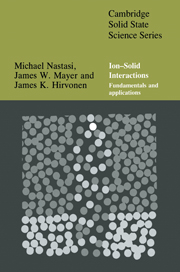Book contents
- Frontmatter
- Contents
- List of symbols
- Preface
- Chapter 1 General features and fundamental concepts
- Chapter 2 Interatomic potentials
- Chapter 3 Dynamics of binary elastic collisions
- Chapter 4 Cross-section
- Chapter 5 Ion stopping
- Chapter 6 Ion range and range distribution
- Chapter 7 Radiation damage and spikes
- Chapter 8 Ion–solid simulations and diffusion
- Chapter 9 Sputtering
- Chapter 10 Order–disorder and ion implantation metallurgy
- Chapter 11 Ion beam mixing
- Chapter 12 Phase transformations
- Chapter 13 Ion beam assisted deposition
- Chapter 14 Applications of ion beam processing techniques
- Chapter 15 Ion beam system features
- Appendix A Crystallography
- Appendix B Table of the elements
- Appendix C Density of states
- Appendix D Derivation of the Thomas–Fermi differential equation
- Appendix E Center-of-mass and laboratory scattering angles
- Appendix F Miedema's semi-empirical model for the enthalpy of formation in the liquid and solid states
- Appendix G Implantation metallurgy – study of equilibrium alloys
- Appendix H Physical constants, conversions and useful combinations
- Index
Appendix G - Implantation metallurgy – study of equilibrium alloys
Published online by Cambridge University Press: 27 January 2010
- Frontmatter
- Contents
- List of symbols
- Preface
- Chapter 1 General features and fundamental concepts
- Chapter 2 Interatomic potentials
- Chapter 3 Dynamics of binary elastic collisions
- Chapter 4 Cross-section
- Chapter 5 Ion stopping
- Chapter 6 Ion range and range distribution
- Chapter 7 Radiation damage and spikes
- Chapter 8 Ion–solid simulations and diffusion
- Chapter 9 Sputtering
- Chapter 10 Order–disorder and ion implantation metallurgy
- Chapter 11 Ion beam mixing
- Chapter 12 Phase transformations
- Chapter 13 Ion beam assisted deposition
- Chapter 14 Applications of ion beam processing techniques
- Chapter 15 Ion beam system features
- Appendix A Crystallography
- Appendix B Table of the elements
- Appendix C Density of states
- Appendix D Derivation of the Thomas–Fermi differential equation
- Appendix E Center-of-mass and laboratory scattering angles
- Appendix F Miedema's semi-empirical model for the enthalpy of formation in the liquid and solid states
- Appendix G Implantation metallurgy – study of equilibrium alloys
- Appendix H Physical constants, conversions and useful combinations
- Index
Summary
Study of metallurgical phenomena
Ion implantation is a powerful tool, useful in the study of alloying phenomena in metals, but the technique has been exploited in that capacity by only a few researchers. The following discussion, taken from the work of S. M. Myers, gives examples of its use for this purpose. Myers (1980) was one of the first to fully utilize ion implantation to study metallurgical phenomena.
The as-implanted ‘surface’ alloy is often metastable on the basis of extended solubilities, as discussed in Chapter 10. Upon heating, the implanted structure returns to an equilibrium situation, and the tracing of this evolution to equilibrium serves to help determine properties such as diffusion rates, solid solubilities, and solute trapping. The study of this transition can be aided by the use of ion beam analysis methods, as well as by conventional electron microscopy, as described below. Myers outlines the evolution of the ion implanted depth distribution and the formalism required to extract the pertinent solid state parameters from the analysis; his approach is paraphrased below.
Diffusion and the composition profile
The quantitative determination of metallurgical properties relies principally on analysis of the time-dependent composition profile obtained during annealing. This analysis involves certain approximations, depending upon the particular experiment, and Myers has outlined the mathematics for certain specific cases, assuming the host to be semi-infinite. The evolution of the implanted distribution during thermal annealing, performed after the implantation has been completed, is of greatest interest.
- Type
- Chapter
- Information
- Ion-Solid InteractionsFundamentals and Applications, pp. 519 - 528Publisher: Cambridge University PressPrint publication year: 1996



